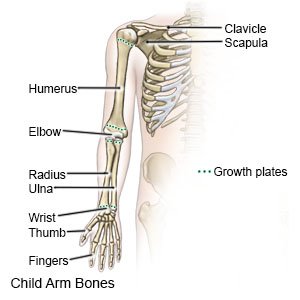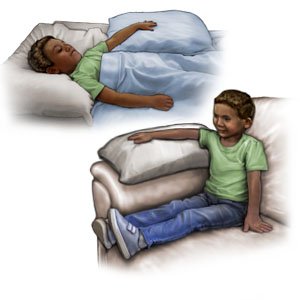Arm Fracture in Children
Medically reviewed by Drugs.com. Last updated on Aug 4, 2025.
AMBULATORY CARE:
An arm fracture
is a break in one or more of the bones in your child's arm.
 |
Common signs and symptoms include the following:
- Arm and shoulder pain
- Swollen and bruised arm
- Abnormal arm position or shape
- Severe pain when your child moves his or her arm
- Weakness or numbness in your child's arm, hand, or fingers
Seek care immediately if:
- Your child's pain gets worse, even after he or she rests and takes medicine.
- Your child's arm, hand, or fingers feel numb.
- Your child's skin over the fracture is swollen, cold, or pale.
- Your child's arm is swollen, red, and feels warm.
- Your child cannot move his or her arm, hand, or fingers.
Call your child's doctor if:
- Your child has a fever.
- Your child's brace or splint becomes wet, damaged, or comes off.
- You have questions or concerns about your child's condition or care.
Treatment
will depend on what kind of fracture your child has, and how bad it is. He or she may need any of the following:
- A support device , such as a brace, cast, or splint may be needed to hold the broken bones in place. It will decrease his or her arm movement and allow it to heal. Do not remove your child's device.
- NSAIDs , such as ibuprofen, help decrease swelling, pain, and fever. This medicine is available with or without a doctor's order. NSAIDs can cause stomach bleeding or kidney problems in certain people. If your child takes blood thinner medicine, always ask if NSAIDs are safe for him or her. Always read the medicine label and follow directions. Do not give these medicines to children younger than 6 months without direction from a healthcare provider.
- Acetaminophen decreases pain and fever. It is available without a doctor's order. Ask how much to give your child and how often to give it. Follow directions. Read the labels of all other medicines your child uses to see if they also contain acetaminophen, or ask your child's doctor or pharmacist. Acetaminophen can cause liver damage if not taken correctly.
- Prescription pain medicine may be given. Ask your child's healthcare provider how to give this medicine safely.
- Closed reduction may be done to put your child's bones back into the correct position without surgery.
- Open reduction surgery may be needed to put your child's bones back into the correct position. An incision is made and the bones are put back in the correct position. This may include the use of wires, pins, plates, or screws.
Help manage your child's symptoms:
- Apply ice on your child's arm for 15 to 20 minutes every hour or as directed. Use an ice pack, or put crushed ice in a plastic bag. Cover it with a towel. Ice helps prevent tissue damage and decreases swelling and pain.
- Elevate your child's arm above the level of his or her heart as often as you can. This will help decrease swelling and pain. Prop his or her arm on pillows or blankets to keep it elevated comfortably.

- Have your child rest his or her arm as much as possible. Do not let your child put pressure on his or her arm or use his or her arm to lift anything. Ask his or her healthcare provider when he or she can return to sports and other activities.
Care for your child's cast or splint:
Follow instructions about when your child may take a bath or shower. It is important not to get the cast or splint wet. Cover the device with 2 plastic bags before you let your child bathe. Tape the bags to your child's skin above the device to help keep out water. Have your child keep his or her arm out of the water in case the bag has a hole or leak.
- Check the skin around your child's cast or splint daily for any redness or open skin.
- Do not let your child use a sharp or pointed object to scratch his or her skin under the brace or splint.
- Do not let your child push down or lean on any part of the cast, because it may break.
Take your child to physical therapy as directed:
A physical therapist can teach your child exercises to help improve movement and strength and to decrease pain.
Follow up with your child's doctor within 1 week:
Your child may need to see a bone specialist within 3 to 4 days if he or she needs surgery or more treatment. Write down your questions so you remember to ask them during your child's visits.
© Copyright Merative 2025 Information is for End User's use only and may not be sold, redistributed or otherwise used for commercial purposes.
The above information is an educational aid only. It is not intended as medical advice for individual conditions or treatments. Talk to your doctor, nurse or pharmacist before following any medical regimen to see if it is safe and effective for you.
Learn more about Arm Fracture
Treatment options
Care guides
Symptoms and treatments
Medicine.com guides (external)
Further information
Always consult your healthcare provider to ensure the information displayed on this page applies to your personal circumstances.
